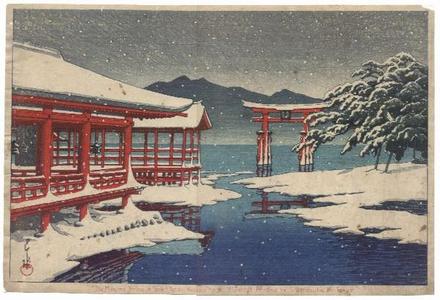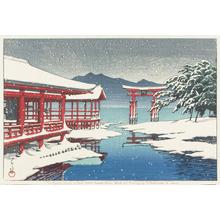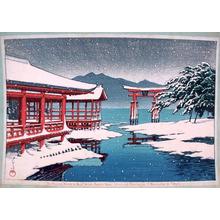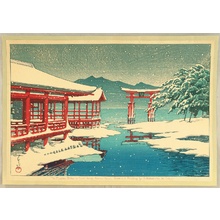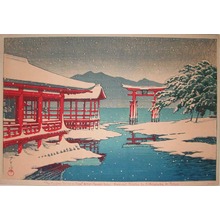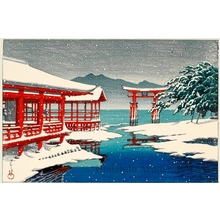Kawase Hasui创作的日本版画《Miyajima Shrine in the Snow》
艺术家:Kawase Hasui
标题:Miyajima Shrine in the Snow
日期:1935
详情:更多信息...
来源:Japanese Art Open Database
浏览所有17,130幅版画...
描述:
Kawase Hasui Miyajima Shrine in the Snow In an auction listing, Thomas Crossland provides this description of a Hasui print: Japanese Woodblock by Hasui 'Miyajima Shrine' (1935) "Beautiful wintertime lake/shrine scene by Hasui Kawase (1887-1957) titled "Miyajima no Yukigeshiki" (or, "Miyajima Shrine in the Snow") and dated 1935. Print bears Hasui's "seal" and signature in the extreme lower/left corner as usual, however, does not have the typical "kanji" margin-dating and title as usually seen in Hasui's prints. Instead, this print - clearly being for foreign export - has that woodblock-printed in English characters across the bottom margin. "(A very reliable and knowledgeable expert has informed me that this (English-titled) printing was issued at the same time as the Japanese-"kanji" version, albeit on somewhat thinner paper. That said, both are to be considered as "first editions," as none apparently were subsequently printed.) Circa 1935." Our trusty shortwave wireless was able to pick up the original transmission that so fortified our Mr. Crossland. Bouncing in off the inversion layer, here it is: "This print, Miyajima no Yukigeshiki (Snow Scene at Miyajima Shrine) was done in 1935. This was a time of bad economic conditions in Japan and high quality paper was scarce. The print was done on the standard high quality paper until that paper ran out, then Watanabe subsitituted a thinner paper that did not have the texture and fineness. It was a print that was destined for export and thus the English title at the bottom of the print. There are no copyright markings and no [transmission lost]. The margins are closely trimmed (to save paper). There should be strong markings in the sky showing the intense rubbing done during the printing process. "I have seen excellent versions of this print as well as poor versions. All seem to be from the first printing. The exact number of prints is unknown, but I estimate that the high quality paper saw about 300 prints, while the poorer quality paper saw about 500 prints."
